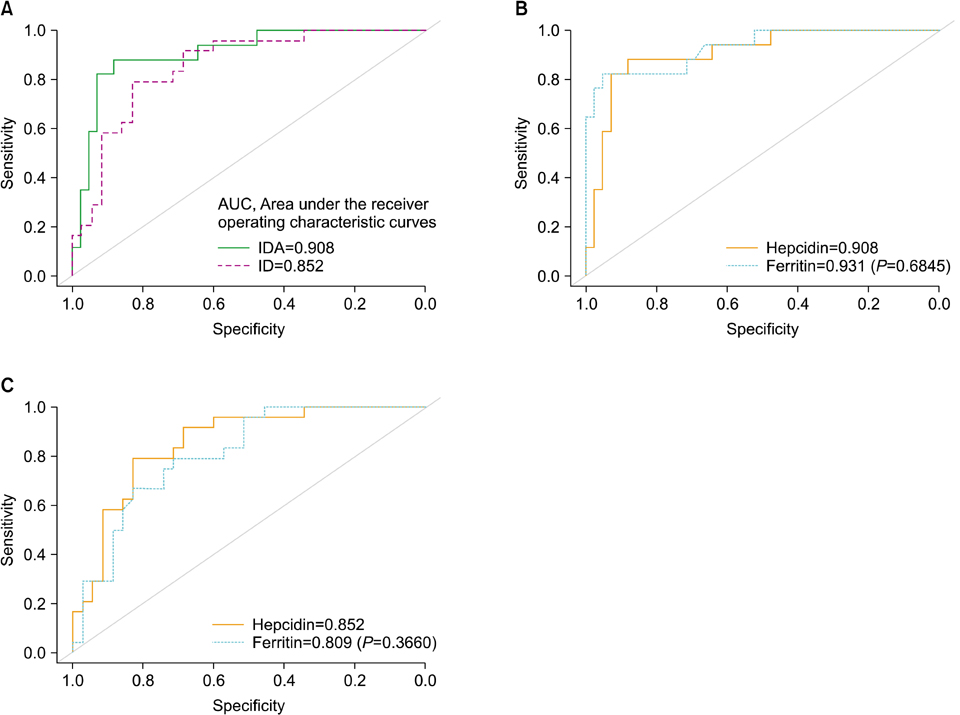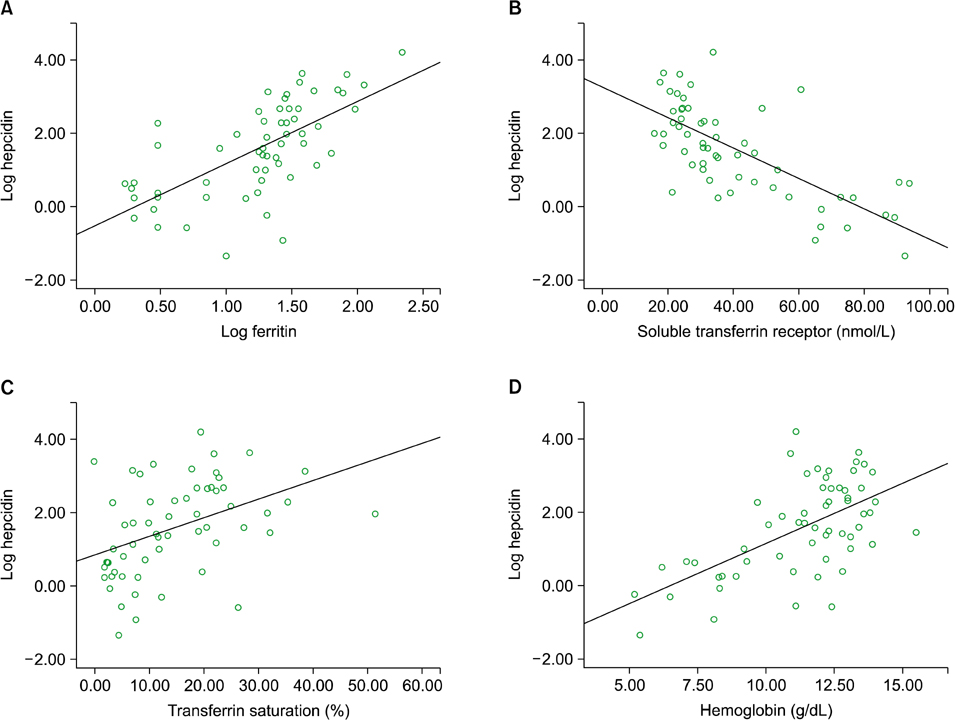Korean J Hematol.
2012 Dec;47(4):286-292. 10.5045/kjh.2012.47.4.286.
Serum hepcidin levels and iron parameters in children with iron deficiency
- Affiliations
-
- 1Department of Pediatrics, Seoul National University Bundang Hospital, Seoul National University College of Medicine, Seongnam, Korea. hryang@snubh.org
- 2Department of Laboratory Medicine, Seoul National University Hospital, Seoul National University College of Medicine, Seoul, Korea.
- 3Department of Pediatrics, Chosun University Hospital, Gwangju, Korea.
- 4Department of Laboratory Medicine & Genetics, Samsung Medical Center, Sungkyunkwan University School of Medicine, Seoul, Korea.
- KMID: 1832108
- DOI: http://doi.org/10.5045/kjh.2012.47.4.286
Abstract
- BACKGROUND
Iron deficiency (ID) and iron deficiency anemia (IDA) are common nutritional disorders in children. Hepcidin, a peptide hormone produced in the liver, is a central regulator of systemic iron metabolism. We evaluated whether serum hepcidin levels can diagnose ID in children.
METHODS
Sera from 59 children (23 males and 36 females; 5 months to 17 years) were analyzed for hepcidin-25 by ELISA. Patients were classified according to hemoglobin level and iron parameters as: IDA, (N=17), ID (N=18), and control (N=24).
RESULTS
Serum hepcidin, ferritin, soluble transferrin receptor (sTfR), transferrin saturation, and hemoglobin levels differed significantly between groups (P<0.0001). Serum hepcidin and ferritin levels (mean+/-SD) were 2.01+/-2.30 and 7.00+/-7.86, 7.72+/-8.03 and 29.35+/-24.01, 16.71+/-14.74 and 46.40+/-43.57 ng/mL in the IDA, ID, and control groups, respectively. The area under the receiver operating characteristic curve for serum hepcidin as a predictor of ID was 0.852 (95% CI, 0.755-0.950). Hepcidin < or =6.895 ng/mL had a sensitivity of 79.2% and specificity of 82.8% for the diagnosis of ID. Serum hepcidin levels were significantly correlated with ferritin, transferrin saturation, and hemoglobin levels and significantly negatively correlated with sTfR level and total iron binding capacity (P<0.0001).
CONCLUSION
Serum hepcidin levels are significantly associated with iron status and can be a useful indicator of ID. Further studies are necessary to validate these findings and determine a reliable cutoff value in children.
Keyword
MeSH Terms
-
Anemia, Iron-Deficiency
Antimicrobial Cationic Peptides
Child
Enzyme-Linked Immunosorbent Assay
Ferritins
Hemoglobins
Humans
Iron
Liver
Male
Nutrition Disorders
Receptors, Transferrin
ROC Curve
Sensitivity and Specificity
Transferrin
Antimicrobial Cationic Peptides
Ferritins
Hemoglobins
Iron
Receptors, Transferrin
Transferrin
Figure
Cited by 1 articles
-
Hepcidin and iron parameters in children with anemia of chronic disease and iron deficiency anemia
Gunjan Mahajan, Sunita Sharma, Jagdish Chandra, Anita Nangia
Blood Res. 2017;52(3):212-217. doi: 10.5045/br.2017.52.3.212.
Reference
-
1. Zimmermann MB, Hurrell RF. Nutritional iron deficiency. Lancet. 2007. 370:511–520.
Article2. Kroot JJ, Tjalsma H, Fleming RE, Swinkels DW. Hepcidin in human iron disorders: diagnostic implications. Clin Chem. 2011. 57:1650–1669.
Article3. Ganz T. Hepcidin, a key regulator of iron metabolism and mediator of anemia of inflammation. Blood. 2003. 102:783–788.
Article4. Kemna EH, Tjalsma H, Willems HL, Swinkels DW. Hepcidin: from discovery to differential diagnosis. Haematologica. 2008. 93:90–97.
Article5. Nemeth E, Tuttle MS, Powelson J, et al. Hepcidin regulates cellular iron efflux by binding to ferroportin and inducing its internalization. Science. 2004. 306:2090–2093.
Article6. Nemeth E, Ganz T. The role of hepcidin in iron metabolism. Acta Haematol. 2009. 122:78–86.
Article7. Ganz T. Hepcidin and iron regulation, 10 years later. Blood. 2011. 117:4425–4433.
Article8. Ganz T, Olbina G, Girelli D, Nemeth E, Westerman M. Immunoassay for human serum hepcidin. Blood. 2008. 112:4292–4297.
Article9. Lasocki S, Baron G, Driss F, et al. Diagnostic accuracy of serum hepcidin for iron deficiency in critically ill patients with anemia. Intensive Care Med. 2010. 36:1044–1048.
Article10. Pasricha SR, McQuilten Z, Westerman M, et al. Serum hepcidin as a diagnostic test of iron deficiency in premenopausal female blood donors. Haematologica. 2011. 96:1099–1105.
Article11. Thomas C, Kobold U, Thomas L. Serum hepcidin-25 in comparison to biochemical markers and hematological indices for the differentiation of iron-restricted erythropoiesis. Clin Chem Lab Med. 2011. 49:207–213.
Article12. Rehu M, Punnonen K, Ostland V, et al. Maternal serum hepcidin is low at term and independent of cord blood iron status. Eur J Haematol. 2010. 85:345–352.
Article13. Müller KF, Lorenz L, Poets CF, Westerman M, Franz AR. Hepcidin concentrations in serum and urine correlate with iron homeostasis in preterm infants. J Pediatr. 2012. 160:949–953.e2.
Article14. Wu TW, Tabangin M, Kusano R, Ma Y, Ridsdale R, Akinbi H. The utility of serum hepcidin as a biomarker for late-onset neonatal sepsis. J Pediatr. 2012. [Epub ahead of print].
Article15. Brătescu LO, Bârsan L, Munteanu D, Stancu S, Mircescu G. Is hepcidin-25 a clinically relevant parameter for the iron status in hemodialysis patients? J Ren Nutr. 2010. 20:5 Suppl. S77–S83.
Article16. Prentice AM, Doherty CP, Abrams SA, et al. Hepcidin is the major predictor of erythrocyte iron incorporation in anemic African children. Blood. 2012. 119:1922–1928.
Article17. Park CH, Valore EV, Waring AJ, Ganz T. Hepcidin, a urinary antimicrobial peptide synthesized in the liver. J Biol Chem. 2001. 276:7806–7810.
Article18. Yapakçi E, Ecevit A, Gökmen Z, Tarcan A, Ozbek N. Erythrocyte transfusions and serum prohepcidin levels in premature newborns with anemia of prematurity. J Pediatr Hematol Oncol. 2009. 31:840–842.
Article19. Tiker F, Celik B, Tarcan A, Kilicdag H, Ozbek N, Gurakan B. Serum pro-hepcidin levels and relationships with iron parameters in healthy preterm and term newborns. Pediatr Hematol Oncol. 2006. 23:293–297.
Article20. Frazer DM, Anderson GJ. Hepcidin compared with prohepcidin: an absorbing story. Am J Clin Nutr. 2009. 89:475–476.
Article21. Kroot JJ, Kemna EH, Bansal SS, et al. Results of the first international round robin for the quantification of urinary and plasma hepcidin assays: need for standardization. Haematologica. 2009. 94:1748–1752.
Article22. Galesloot TE, Vermeulen SH, Geurts-Moespot AJ, et al. Serum hepcidin: reference ranges and biochemical correlates in the general population. Blood. 2011. 117:e218–e225.
Article23. Cherian S, Forbes DA, Cook AG, et al. An insight into the relationships between hepcidin, anemia, infections and inflammatory cytokines in pediatric refugees: a cross-sectional study. PLoS One. 2008. 3:e4030.
Article24. Sanad M, Gharib AF. Urinary hepcidin level as an early predictor of iron deficiency in children: A case control study. Ital J Pediatr. 2011. 37:37.
Article25. Fan J, Upadhye S, Worster A. Understanding receiver operating characteristic (ROC) curves. CJEM. 2006. 8:19–20.
Article26. Guyatt GH, Oxman AD, Ali M, Willan A, McIlroy W, Patterson C. Laboratory diagnosis of iron-deficiency anemia: an overview. J Gen Intern Med. 1992. 7:145–153.
Article27. Punnonen K, Irjala K, Rajamäki A. Serum transferrin receptor and its ratio to serum ferritin in the diagnosis of iron deficiency. Blood. 1997. 89:1052–1057.
Article28. Theurl I, Aigner E, Theurl M, et al. Regulation of iron homeostasis in anemia of chronic disease and iron deficiency anemia: diagnostic and therapeutic implications. Blood. 2009. 113:5277–5286.
Article29. Kroot JJ, Hendriks JC, Laarakkers CM, et al. (Pre)analytical imprecision, between-subject variability, and daily variations in serum and urine hepcidin: implications for clinical studies. Anal Biochem. 2009. 389:124–129.
Article30. Nemeth E. Targeting the hepcidin-ferroportin axis in the diagnosis and treatment of anemias. Adv Hematol. 2010. 2010:750643.
Article
- Full Text Links
- Actions
-
Cited
- CITED
-
- Close
- Share
- Similar articles
-
- Serum Pro-hepcidin as an Predictor of Iron Deficiency in Anemic Patients
- Understanding and exploiting hepcidin as an indicator of anemia due to chronic kidney disease
- Hepcidin and iron parameters in children with anemia of chronic disease and iron deficiency anemia
- Loss of progesterone receptor membrane component 1 decreases hepatic hepcidin levels in animal model
- Basic Understanding of Iron Metabolism




